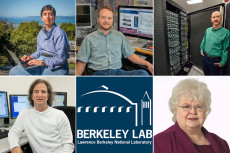CRD Researchers Honored with Director’s Awards for Exceptional Achievement
September 14, 2015
Jon Bashor, jbashor@lbl.gov, 510-486-5849

The award recipeients: (Top row, clockwise) Deborah Agarwal (CRD), Eli Dart (ESnet), Brent Draney (NERSC), Lynne Rippe (NERSC) and James Sethian (CRD).
Five employees in the Computing Sciences organization are recipients of this year’s Director’s Awards for Exceptional Achievement, which were announced on Friday, Sept. 11. The honorees will be recognized at a future Lab awards ceremony and reception.
“It’s very gratifying to see labwide acknowledgement of the contributions that our Computing Sciences colleagues are making both at the lab and in the broader research community,” said Kathy Yellick, Associate Lab Director for Computing Sciences. “Please join me in congratulating all of them on their well-deserved recognition.”
Here is a list of this year’s CS recipients:
Deb Agarwal, head of CRD’s Data Science and Technology Department, was recognized for her effort to support diversity at the lab. Among her contributions, Agarwal is a member of the organizing committee for the annual Grace Hopper Celebration of Women in Computing, leads the Computing Sciences Diversity Working Group and led the development of the CS mentoring program. Agarwal was honored in the area of diversity for "mentoring and leadership roles promoting diversity."
Eli Dart of ESnet’s Science Engagement Team and Brent Draney, head of NERSC’s Networking, Security and Servers Group, were recognized for their work in developing the Science DMZ, a network architecture that allows science data to securely bypass institutional firewalls. The Science DMZ has been endorsed by the National Science Foundation, which has funded Science DMZs t more than 100 universities across the country. Dart and Draney were honored in the area of operations for “achievement in operational effectiveness, process re-engineering or improvement, resource management and efficiency, or partnerships across organizational/departmental boundaries.”
James Sethian, head of CRD’s Mathematics Group, was recognized for establishing CAMERA, the Center for Advanced Mathematics for Energy Research Applications. CAMERA has fostered truly interdisciplinary teams of computational scientists and experimentalists to develop methods and tools and placed Berkeley Lab in a leading position for addressing new mathematical and data challenges facing DOE experimental facilities. Sethian was recognized in the area of service for management “in support of the Lab’s mission and strategic goals provided in a spirit of cooperation and commitment to excellence.”
Lynn Rippe was awarded a Berkeley Lab Citation for her longtime procurement work in support of NERSC. Rippe, a lead subcontracts administrator with the Office of the Chief Financial Officer, has been the procurement department lead on every major NERSC system dating back to the center’s days at Lawrence Livermore She was also responsible for the development of the Best Value Source Selection process for large-scale computer procurements that has been widely adopted within DOE laboratories.The Berkeley Lab Citation recognizes the highest level of service to Berkeley Lab and the network of DOE laboratories.About Berkeley Lab
Founded in 1931 on the belief that the biggest scientific challenges are best addressed by teams, Lawrence Berkeley National Laboratory and its scientists have been recognized with 16 Nobel Prizes. Today, Berkeley Lab researchers develop sustainable energy and environmental solutions, create useful new materials, advance the frontiers of computing, and probe the mysteries of life, matter, and the universe. Scientists from around the world rely on the Lab’s facilities for their own discovery science. Berkeley Lab is a multiprogram national laboratory, managed by the University of California for the U.S. Department of Energy’s Office of Science.
DOE’s Office of Science is the single largest supporter of basic research in the physical sciences in the United States, and is working to address some of the most pressing challenges of our time. For more information, please visit energy.gov/science.









